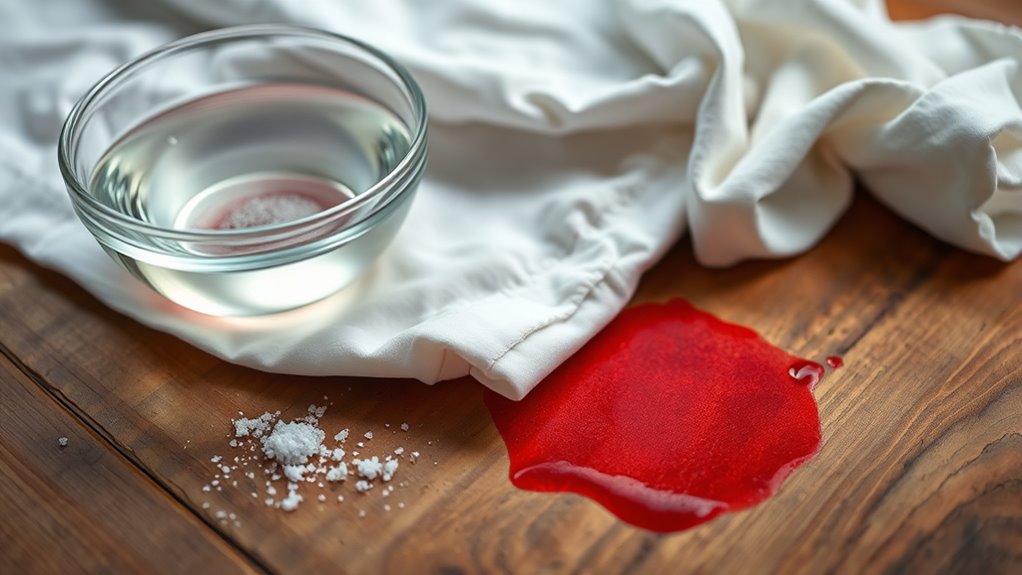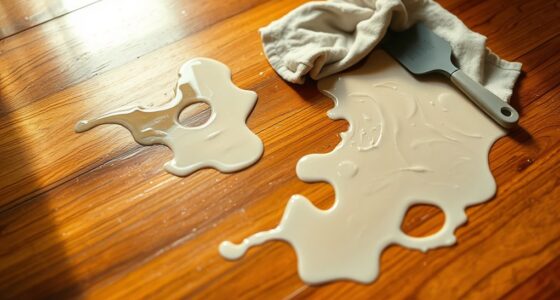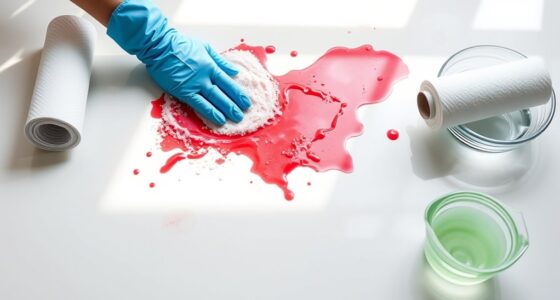To quickly remove blood stains from fabrics, act fast! Rinse the stained area with cold water to flush out the blood. Blot the stain gently with a clean cloth; don’t rub or use hot water, as that’ll set the stain. For dried stains, scrape off loose debris, then apply hydrogen peroxide for light fabrics or a baking soda paste for dark ones. Use enzyme-based cleaners for the best results. Discover more effective methods ahead!
Key Takeaways
- Rinse fresh blood stains with cold water immediately to flush out as much blood as possible before further treatment.
- For dried stains, scrape off loose particles and apply hydrogen peroxide or a baking soda paste based on fabric color.
- Use enzyme-based detergents in cold water to effectively break down protein stains during the washing process.
- Always blot stains gently with a clean cloth to prevent spreading, and avoid rubbing or using hot water.
- Inspect the fabric after washing and air dry to ensure complete stain removal before considering any heat exposure.
Understanding Blood Stains and Their Composition
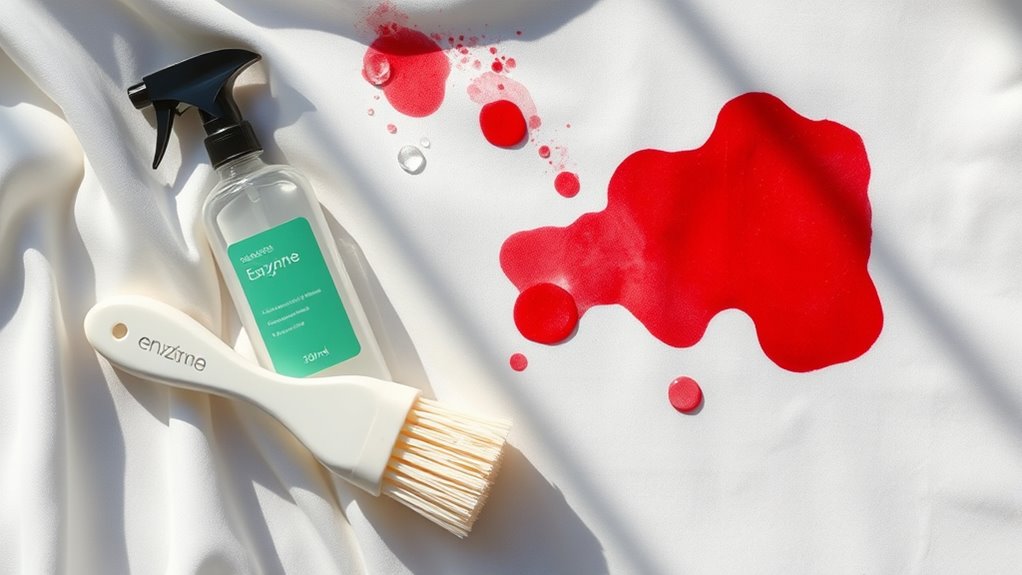
When you encounter a blood stain, understanding its composition can make a big difference in how you tackle the cleaning process.
Blood primarily consists of plasma, red blood cells, white blood cells, and platelets. Plasma, which makes up about 50-65% of blood, contains proteins and nutrients that contribute to the stain’s complexity. White blood cells help fight infections and play a role in the body’s response to injury, which can affect the nature of the stain. Red blood cells transport oxygen, while white blood cells help fight infections.
Blood is a complex mixture of plasma, red and white blood cells, and platelets, influencing its stain characteristics.
When blood stains form, they can be passive, transfer, or projected, depending on how they appear. Remember that blood stains are protein-based, requiring enzyme cleaners for effective removal.
The speed of your cleaning efforts is essential, as fresh stains are much easier to treat than dried ones, which can set the proteins more firmly in the fabric.
Immediate Actions for Fresh Blood Stains
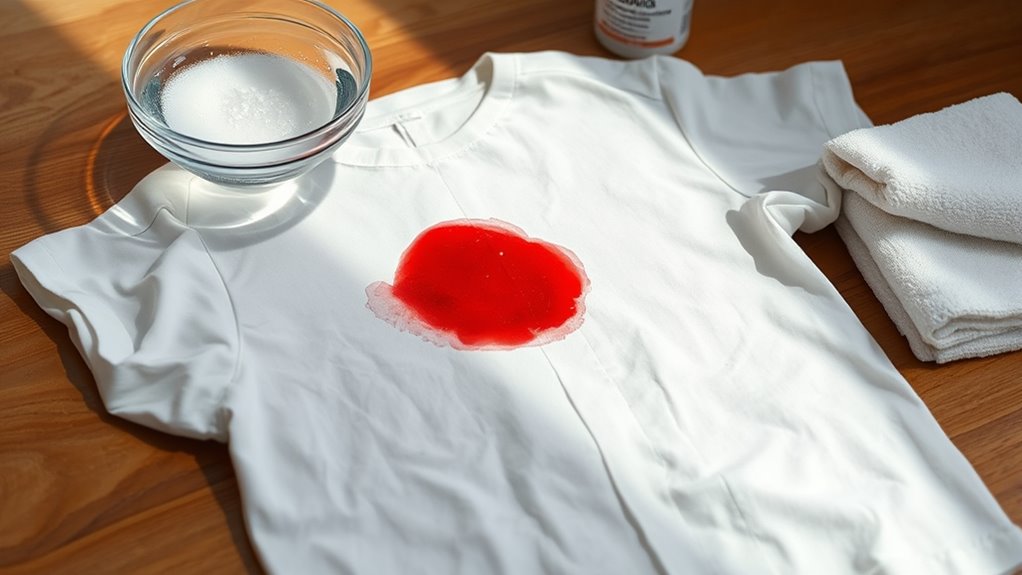
To effectively tackle fresh blood stains, you need to act quickly and use the right techniques.
Start by rinsing the stained fabric with cold water to flush out as much blood as possible. While rinsing, use blotting techniques with a clean cloth or paper towel to absorb the excess blood—don’t rub, as that can spread the stain. Speed is crucial in treating blood stains, so ensure you address them immediately for the best results.
Avoid using heat, which can set the stain, making it harder to remove. Check the fabric type to verify you’re using the correct care methods.
If needed, you can gently rub bar soap into the stain or apply hydrogen peroxide.
Effective Methods for Removing Dried Blood Stains
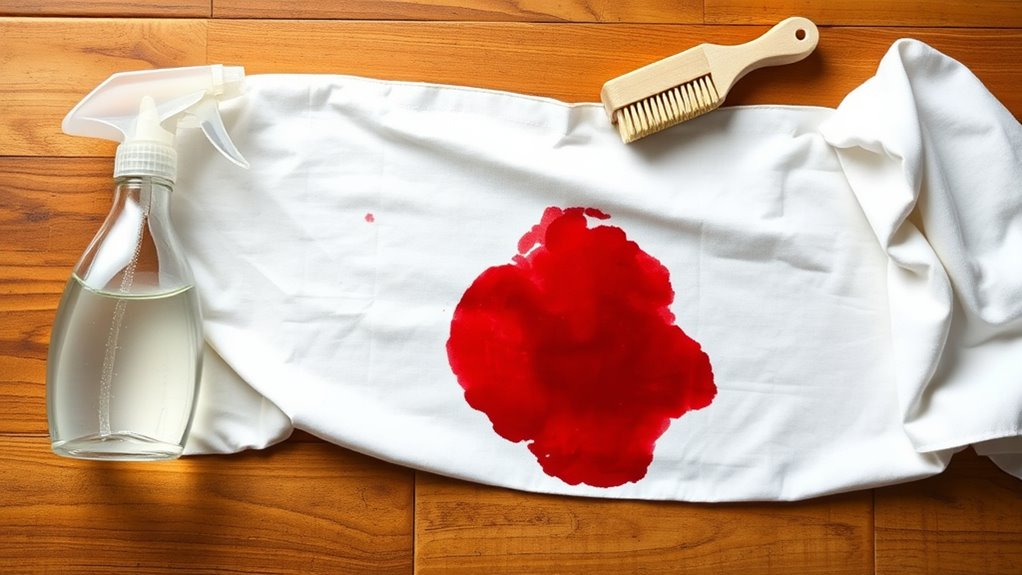
Though dried blood stains can be stubborn, various effective methods can help you reclaim your fabrics. Start by scraping off any loose particles with a blunt knife.
For light-colored fabrics, dab hydrogen peroxide on the stain, but watch for color loss. For dark clothing, create a baking soda paste, apply it, and let it sit before washing. Enzyme-based detergents work wonders in cold water, breaking down protein stains. You can also soak garments in cold water with a stain remover for several hours.
If needed, rub bar soap into the stain and blot with cold water. Remember, patience is key; sometimes, multiple treatments are necessary to fully remove those stubborn stains. Additionally, always test cleaning agents on a small, inconspicuous area first to avoid damage.
Special Care for Delicate Fabrics
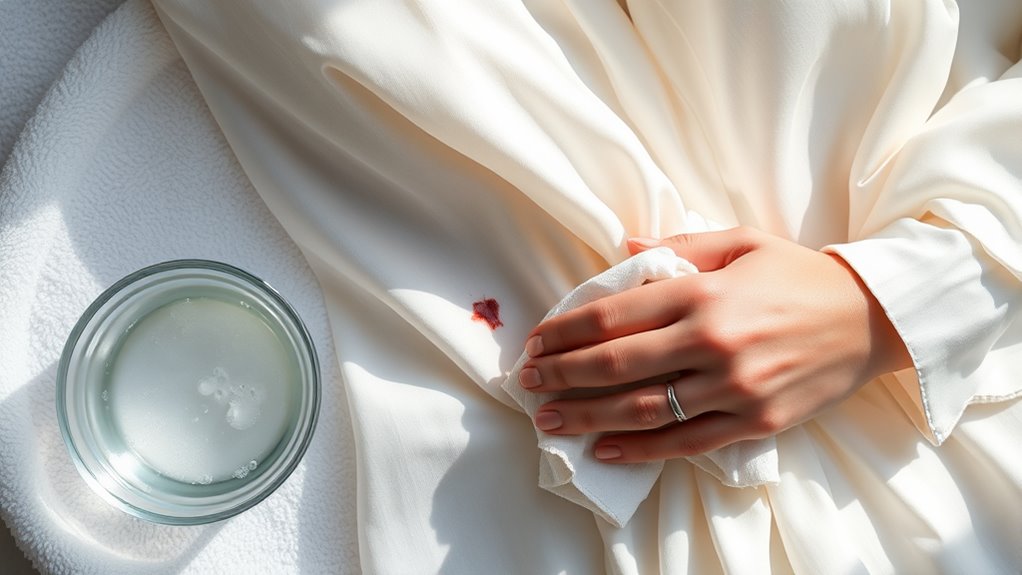
Since delicate fabrics like silk and wool can easily be damaged, handling blood stains with care is crucial.
Start by identifying the fabric and using enzyme-based stain removers designed for delicate materials. Instead of rubbing, gently blot the stain with a clean cloth to prevent spreading. Always use cold water to avoid setting the stain, as blood stains can be tough to remove due to the proteins that bind to the fabric.
Before applying any cleaner, test a small, inconspicuous area to verify it won’t damage the fabric. For silk, sponge the stain with a mild detergent solution, while for wool, soak the area in a salt solution.
Avoid bleach and be cautious with vinegar. If the stain persists, consider seeking professional cleaning to protect your delicate fabrics.
Household Remedies for Blood Stain Treatment
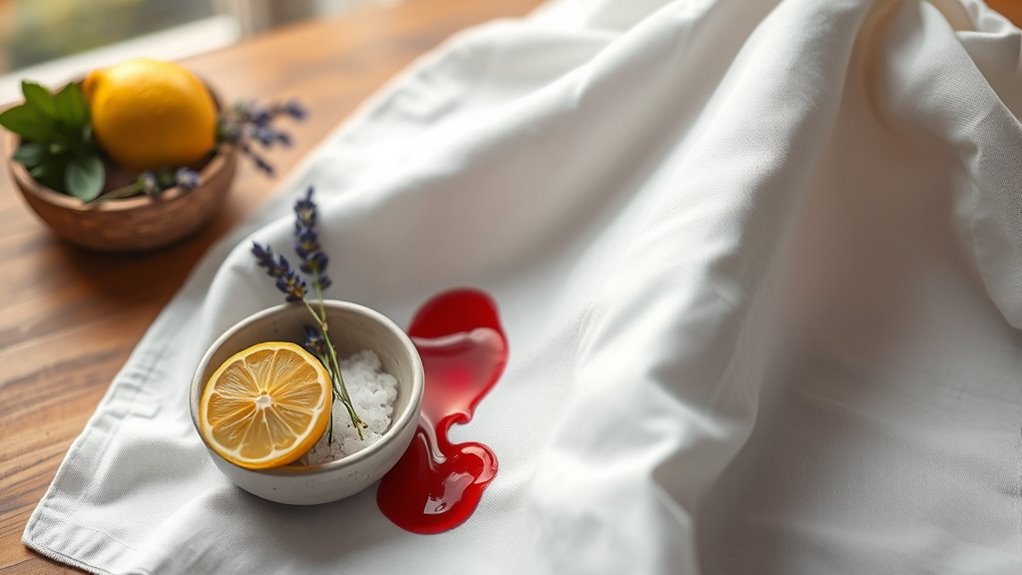
When it comes to tackling blood stains, several effective household remedies can help you restore your fabrics. For fresh stains, soak the area in white vinegar for about 10 minutes. Immediate care for fresh wounds is crucial to prevent stains from setting in. If the stain is dried, hydrogen peroxide can work wonders—just test it on a hidden spot first. You can also mix baking soda with water to create a paste; apply it to the stain and let it sit for half an hour. Salt mixed with water can act as a dehydrating agent; apply, let dry, and rinse. Dish soap is another option—scrub the stain gently with it.
The Role of Enzyme-Based Cleaners
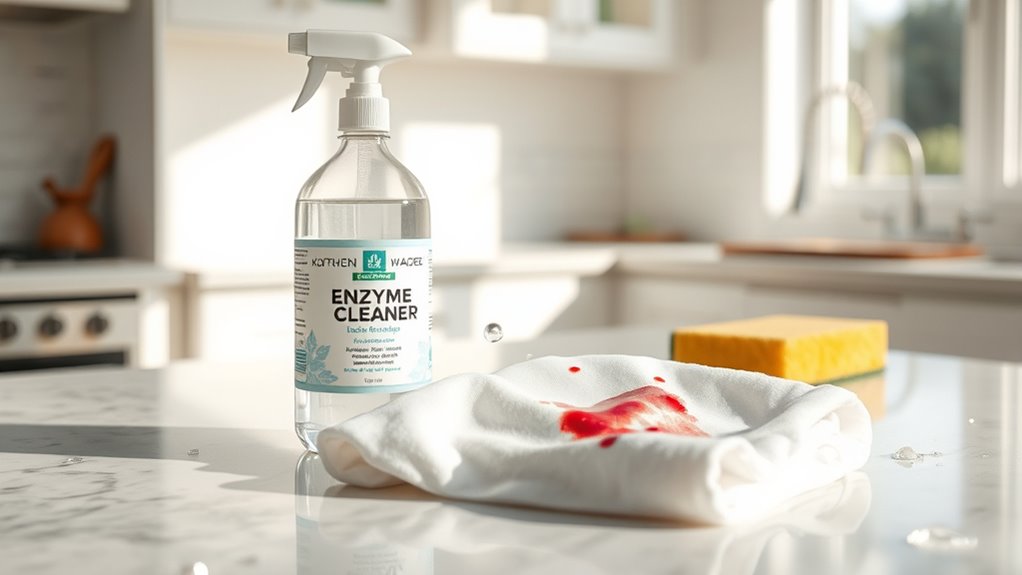
Enzyme-based cleaners play an essential role in effectively removing blood stains from fabrics, as they target the proteins that make up the stain.
Protease enzymes break down these proteins into smaller, washable molecules, while surfactants help loosen and lift the stain from the fabric.
For best results, saturate the stained area with the cleaner and let it sit for 15-20 minutes before washing in cold water.
Always test the cleaner on an inconspicuous fabric area first to avoid damage.
Enzyme cleaners are gentle on most colorfast fabrics like cotton and linen but should be used cautiously on delicate materials.
Quick application is key, as immediate action leads to the most efficient stain removal.
Tips for Preventing Blood Stains
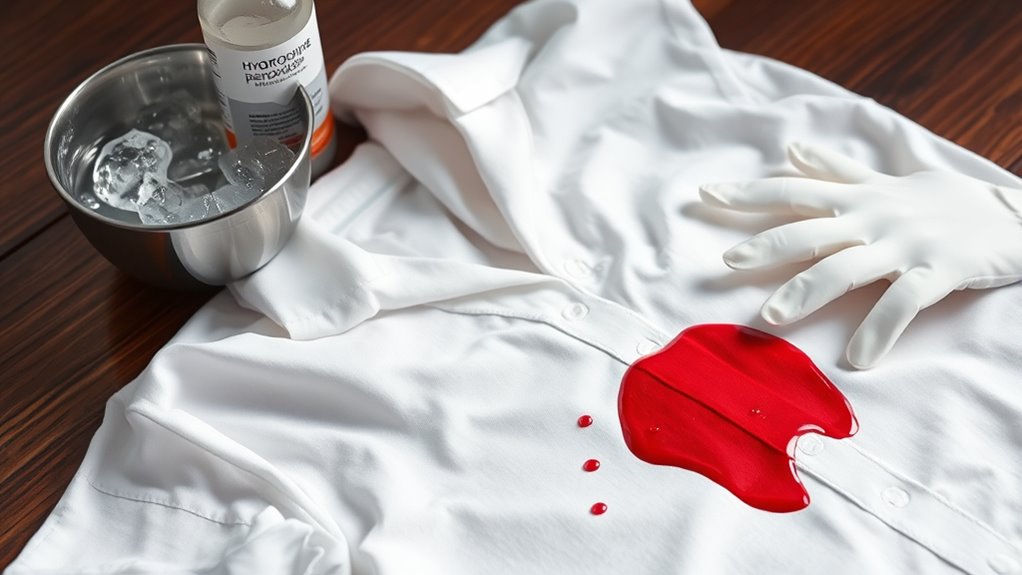
To effectively prevent blood stains, taking immediate action is essential, as it greatly reduces the chance of them setting in. Always treat any potential stains right away, using cold water to minimize setting.
Consider wearing protective clothing like aprons or gloves in situations where blood exposure is likely. Opt for stain-resistant fabrics, which make cleaning much easier. Regularly wash your clothes to avoid dirt buildup, and pre-treat fabrics with stain repellents to enhance their resistance.
Be aware of the fabric type—synthetic fibers can trap stains more than natural ones. Finally, maintain good hygiene and employ safety practices to minimize unexpected blood exposure.
Common Mistakes to Avoid When Treating Blood Stains
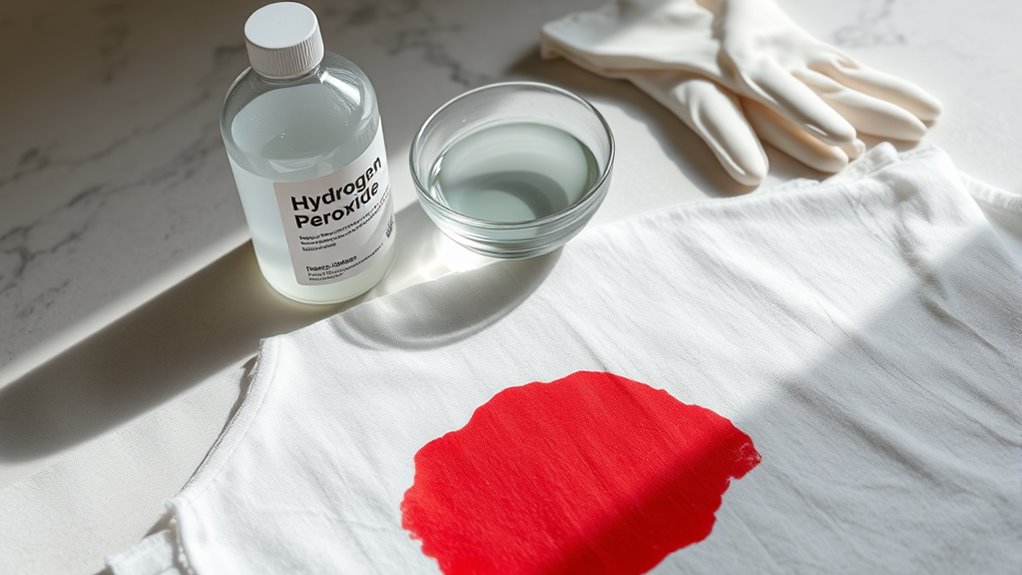
Although treating blood stains can seem straightforward, many common mistakes can complicate the process and make removal more difficult.
First, avoid using hot water, as it can set the stain permanently. Rubbing the stain aggressively spreads it further, while excessive pressure pushes it deeper into the fabric. Prompt treatment with proper methods is essential for effective stain removal, especially since fresh stains are easier to remove than older, set-in stains.
Act quickly—delaying treatment allows blood to dry and bind to fibers. Always consider fabric type; delicate materials like silk need gentle care.
Don’t overload on cleaning products, and remember to test solutions on hidden areas.
Finally, using chlorine bleach can worsen the stain, so use cold water and enzymatic detergents instead.
If the stain persists, don’t hesitate to seek professional help.
Final Steps After Stain Removal
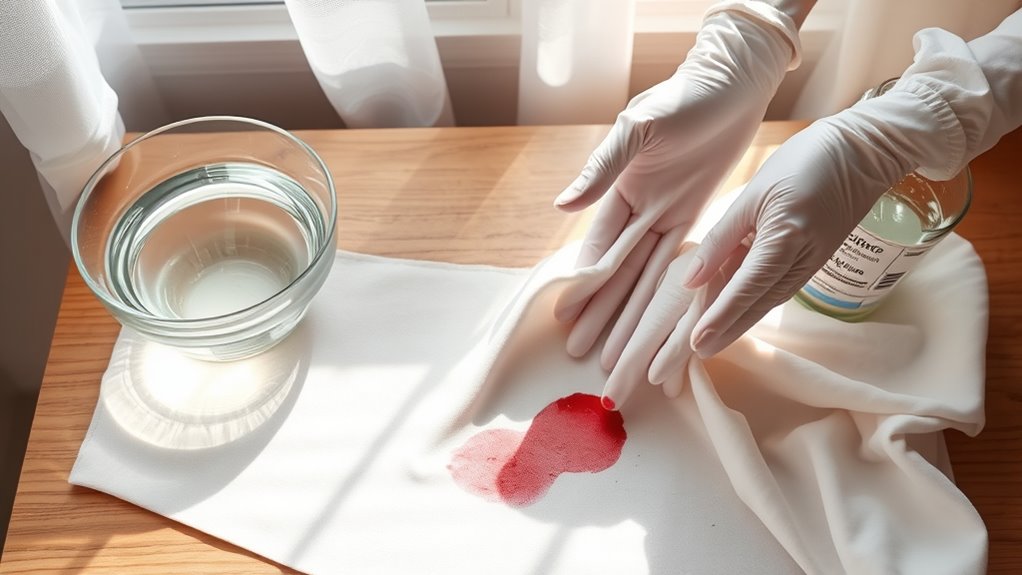
Once you’ve blotted and rinsed the blood stain, it’s crucial to take the final steps for effective removal.
Rinse the fabric liberally with cold water to eliminate any residue. If discoloration remains, apply an enzyme cleaner to break down the proteins in the stain. Dried blood stains can still be removed with patience and heavy-duty stain removers, so it’s important to treat them promptly.
Rinse the fabric thoroughly with cold water; use an enzyme cleaner for stubborn discoloration to effectively tackle the stain.
Continue blotting with cold water until the stain is nearly gone, then inspect the fabric for any lingering marks.
Wash the garment in cold water using a gentle detergent, avoiding the dryer until the stain is completely removed.
After washing, check for any remaining discoloration and repeat the treatment if necessary.
Always air dry the fabric to prevent heat from setting any residual stains.
Frequently Asked Questions
Can I Use Hot Water to Remove Blood Stains?
You might think using hot water will help remove blood stains, but it can actually set the stain deeper into the fabric.
Blood contains proteins that bond more tightly when heated, making it harder to clean. Instead, you should use cold water to rinse the stain right away.
Cold water helps loosen the blood and prevents it from setting, giving you a better chance of complete removal. Stick with cold for best results!
How Do I Know if a Stain Is Set?
You might think every stain is a temporary nuisance, but some become like unwelcome houseguests that refuse to leave!
To know if a stain’s set, look for color changes and a rigid texture. If it’s spread beyond the original spill, it’s likely embedded.
Stains that resist washing and those that appeared after a wash are strong indicators too. Quick action stops stains from settling, so act fast next time!
What if the Fabric Label Is Missing?
If the fabric label’s missing, don’t panic!
Start by testing a small, hidden area of the fabric with cold water and a mild detergent. This’ll help you gauge its sensitivity.
If you’re unsure, look up similar fabrics online for guidance.
Avoid heat and harsh chemicals to prevent damage.
If you still can’t determine how to treat it, consider consulting a professional cleaner who can provide tailored advice for your fabric type.
Are Blood Stains Permanent on All Fabrics?
Blood stains can feel like a haunting memory on your favorite fabrics, but they’re not always permanent.
If you act quickly and use the right methods, you can often rescue your items. Different fabrics respond differently, so treat each with care.
How Can I Protect My Clothes From Future Stains?
To protect your clothes from future stains, start by applying a fabric protector like Nasiol’s PerWear, which creates an invisible barrier against liquids.
You can also consider using stain guards available at dry cleaners, especially on lighter fabrics.
Always act quickly when a spill occurs—blot instead of rubbing to prevent spreading.
Opt for eco-friendly detergents and wash in cold water to minimize stain setting, ensuring your clothes stay looking fresh longer.
Conclusion
In the battle against blood stains, you’ve now got the tools to turn the tide. With quick action and the right methods, those pesky marks don’t stand a chance. Think of your fabrics as a canvas; with a little care, you can restore their beauty as if nothing ever happened. So, arm yourself with these techniques, and let your laundry day be a victory, leaving stains in the dust like yesterday’s news.
